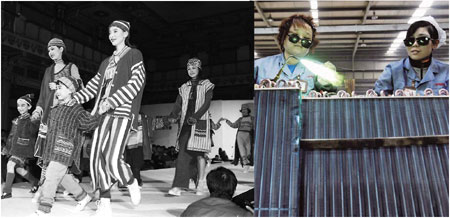Evolving export strategy
|
Left: A textile export company holds a product launch in Beijing on Oct 18, 1995. Right: Workers at a Galanz factory in Zhongshan, Guangdong province, on March 10, 2011. Left: Xinhua; Right:Chen Yehua / Xinhua |
In July 1978, Hong Kong businessman Zhang Zimi approached the Dongguan government, in South China's Guangdong province, with a radical idea: to start making handbags for the Hong Kong market. Zhang's deal called for him to inject HK$2 million and provide the designs and raw materials. All the Dongguan government had to do was to provide the factory and the workers. "We became interested in the proposal when Zhang came to visit us and made a handbag there and then, based on the sample he brought with him," says Tang Zhiping, an official from the Dongguan government who was part of the team that looked at Zhang's plan. Shortly after that meeting, the deal was signed and the Taiping Handbag Factory was born.
What made this deal radical was that up until then, China exported mainly agricultural and subsidiary products, and primary goods such as bristles, Chinese wood oil, silk and tea.
Zhang's idea would make Taiping Handbag the first company to start manufacturing processed goods on the Chinese mainland - and export them to Hong Kong - just months after the mainland launched its reform and opening-up policy and its strategy of developing foreign trade.
That year, the mainland signed 22 projects worth $13 billion to buy technology from abroad, but it had only $1.6 billion worth of foreign exchange. The State Council realized the government needed to increase its foreign exchange and introduced measures to encourage the production of goods for export.
"It came naturally," says Long Guoqiang, senior researcher with the Development Research Center of the State Council. "We had neither the technology to develop the economy nor foreign exchange to import technology, but we had abundant cheap labor, so the only choice was to make money and get the technology by utilizing the labor."
Following the success of the Taiping plant, many entrepreneurs from Hong Kong established factories in Dongguan and other cities in the Pearl River Delta region to make shoes, bags, garments and suitcases for export.
This helped push China's foreign trade to $20.6 billion by the end of 1978; the previous year, the country's foreign trade was barely $14.8 billion. And in 1988, China's exports broke through the $100-billion mark. Light and textile goods became the largest category of goods for export, replacing agricultural and primary goods.
China's trade policy continued to evolve. In 1985, the State Council said China would invigorate the mechanical and electrical industries. In 1999, the government launched a strategy to increase trade through science and technology. This led to some manufacturers and exporters moving from making shoes and handbags to designing and producing mechanical and electrical goods such as home appliances.
The Galanz Group was one of them. In 1992, Liang Qingde, the founder of Shunde Guizhou Eiderdown Company which had been exporting goods for 13 years, decided to change tack after a business trip to Japan showed the popularity of microwave ovens.
"Actually, we did well in selling eiderdown goods overseas, but I felt there were limits," says Liang, chairman of the Galanz Group. "So, I considered transition."
Today, Galanz is the largest producer of microwave ovens in the world, and also produces air conditioners.
The rise of Galanz reflects the progress of China's foreign trade. In 1995, mechanical and electrical products overtook textiles to become the top export category. Much of this success can be credited to the biannual Canton Fair, which has been running since 1957. For several decades, the China Import and Export Fair was restricted to only a few State-owned companies.
But in 1999, private companies and institutions were able to do foreign trade. The Qingdao Kingking Group became one beneficiary.
"The news was significant," Chen Suobin, chairman of Kingking, says. And the company, China's largest exporter of candle gifts, grew rapidly. "In 1999, we had only eight booths, but in 2008, we had 40," Chen says.
Another boost to China's exports has been its entry to the WTO in 2001. During the past 10 years, China has reduced average tariffs from 15.3 percent to 9.8 percent, and has removed non-tariff measures, including import quotas and import licenses.
China's exports and imports have surged by a staggering 490 and 470 percent, with foreign trade rising to a high of $2.97 trillion in 2010, from $500 billion in 2001.
In 2009, China became the world's largest exporter, surpassing Germany, despite the fact its exports dropped 16 percent year-on-year to $1.2 trillion. Trade partners have widened to many emerging markets, including Southeast Asian nations, Brazil, Russia and South Africa. But the US, the EU and Japan are still China's top three trade partners.
While exports are on the rise, so are trade remedy cases against it. China has been the major target of trade protectionism for years.
Qiu Quanlin in Guangzhou and Gao Changxin in Shanghai contributed to this story.
(China Daily 06/01/2011 page25)















